St. Paul's Cathedral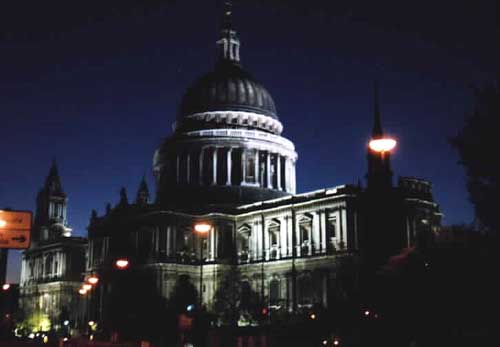 St. Paul's Cathedral at night INFORMATION
Address: St. Paul's Churchyard, London EC4 ADMISSION INFORMATION Admission Times:
Note: NO indoor photography allowed without special permission! 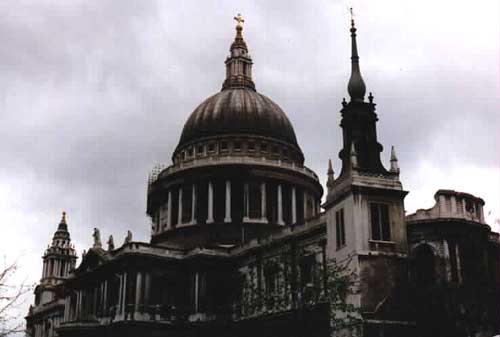 St. Paul's Cathedral on a rainy day
|
 Cathedral History
Cathedral History
St. Paul's is the Cathedral of the Diocese of London and there has been a Bishop of London since Restitutus in 314 AD. It is a focal point of the Anglican Communion, which originated from the Church of England. It retains both its ancient Catholic tradition and its 16th Century Reformation heritage. The actual number of churches that have previously stood on the site now graced by the current St. Paul's Cathedral is uncertain. The original site, it is believed, was founded by King Ethelred of Kent and was endowed with Tillingham Manor in Essex for Mellitus, Bishop of the East Saxons, in 604. It burned down in 675 and was rebuilt, only to be destroyed and rebuilt again following a Viking ransacking in 962. The endowment property to this day remains in the possession of the Dean and Chapter. The cathedral's predecessor, begun by Bishop Maurice in 1087, was known as Old St. Paul's. Because the work on the gothic cathedral was so vast, the project extended into the early 14th C. and became merged with the heavy Norman-style architecture. It became one of the country's greatest medieval churches and was the religious center of London. Old St. Paul's boasted the largest steeple and spire ever built in England to date and was the country's largest church. It was also the third largest cathedral in Europe. It contained the remains of King Ethelred, St. Erkenwald and Bishop William- all of which were recovered from a Saxon cathedral. The Reformation brought various alterations to the cathedral and a fire caused by lightning in 1561 destroyed the spire which was ultimately never replaced. With the public using it as a short-cut and traders selling their wares in the nave, the desecration to the building began to take its toll. The cathedral sank into a steadily worsening condition. A restoration scheme to be carried out by the great architect, Inigo Jones, planned to put an end to the desecration by adding a Corinthian portico to the west front, but the outbreak of the Civil War prevented work from continuing. The Great Fire of London in 1666 dealt the final blow that caused irreparable damage to the cathedral. Sir Christopher Wren (1632-1723), son of a dean and nephew of a bishop, was appointed King's Surveyor-General in 1668 and instructed to examine the extent of decay and damage to the cathedral. Instead, he used gunpowder and battering rams to demolish the remains and subsequently planned a new cathedral to form the heart of the devastated city. Wren's first plan was rejected in 1663, his second plan and model were abandoned in 1673 with his third and final "Warrant Design" winning royal approval in 1675. The foundation stone was laid shortly thereafter and construction continued for 35 years. The first service, a thanksgiving for the Treaty of Ryswick (war against Louis XIV,) was held on December 2, 1697, in the Quire (choir). Work began on the dome a year later when construction reached the height of what is now called the Whispering Gallery. 35 years since the start of the project, the last stone of the structure was laid in 1710. Sir Christopher Wren was removed from the project at this stage and his ideas for the mosaics and interior of the dome never reached fruition. The present monochrome paintings and dome frescoes were instead produced by Sir James Thornhill. St. Paul's became the first British cathedral to have been built in the English Baroque style by a single architect and the only one to have a dome. Sir Christopher Wren died in 1723 at age 91.
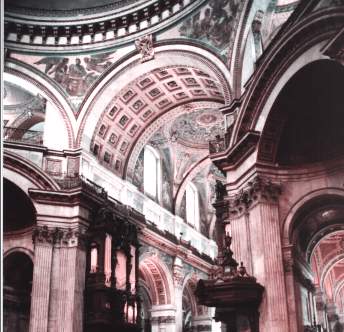 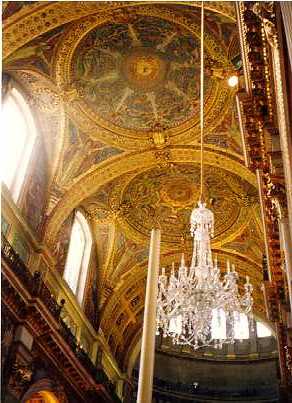 The Ceiling frescoes painted by Sir James Thornhill |
 The Cathedral Today
The Cathedral Today
The Portland stone constructed dome has a diameter of 112 feet. The height from the ground to the top of the surmounting cross reaches an impressive 365 feet. Numerous monuments inside the cathedral include the only monument to have survived the Great Fire- a carving of poet John Dunne, by Nicholas Stone. Entombed in the crypt are the remains of such famous soldiers, sailors and artists as Nelson, Wellington, Jellicoe, Reynolds and Turner. A small fee is charged for entrance into the crypt, Whispering Gallery, Stone Gallery and Golden Gallery- the latter two affording breathtaking views of London and the Thames after climbing a total of 530 steps. Restoration work has rectified damage and destruction of the choir and High Altar- the result of bombing raids during WWII. Notable works of art include carvings by Grinling Gibbons, ironworks by Jean Tijou, and the organ commissioned by Schmidt in 1694. The cathedral's most famous painting, The Light of the World by William Holman Hunt, was donated in 1908 by Charles Booth. St. Paul's contains tributes to Admiral Horatio Nelson, JMW Turner, Captain Robert Falcon Scott, John Howard and more. The Cathedral celebrated its 300th anniversary in 1997. 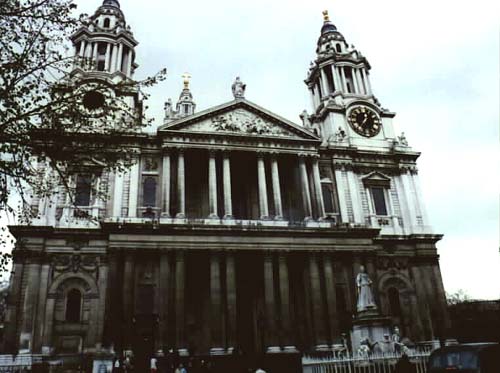 The front facade of the cathedral |
 The Cathedral Today
The Cathedral Today
Links to my other London Attractions pages
Trafalgar Square & Admiralty Arch Permission graciously granted by J. Polos for the use of an interior photograph of St. Paul's Cathedral. If you would like to see his photographic journal of Europe, click here. Couldn't find what you were looking for? Click Here. Home All photographs ©1997-2003 M.D.Cerny unless otherwise indicated. Contact me prior to reproduction/use in a public forum to obtain my permission. Please leave your contact information and the URL where the photograph(s) will be used (if applicable) via the email link above. In exchange for their free use, a small, name text link to my site is required on each page where my photographs are posted. Click here for full legal copy and information about obtaining permission to use my photography. |